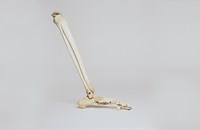 Today’s post comes from a question posed by Twitter follower SH, who asked if her hip pain could be coming from having one leg longer than the other. She went on to say that she only develops symptoms on her left side regardless whether it is Achilles tendon pain or whatever. She did not elaborate on the whatever, and she did not specify which leg of hers was longer. However, neither of those points is necessary for my answer as you will soon see; I found the question interesting and something I would most certainly address at my Beverly Hills, Los Angeles, and West Hollywood chiropractic office.
Today’s post comes from a question posed by Twitter follower SH, who asked if her hip pain could be coming from having one leg longer than the other. She went on to say that she only develops symptoms on her left side regardless whether it is Achilles tendon pain or whatever. She did not elaborate on the whatever, and she did not specify which leg of hers was longer. However, neither of those points is necessary for my answer as you will soon see; I found the question interesting and something I would most certainly address at my Beverly Hills, Los Angeles, and West Hollywood chiropractic office.
Let me first address the leg length inequality: It is not uncommon for a person to develop a difference in leg length – that is, having one leg shorter or longer than the other. In fact, it is rather common. Do not read common to mean normal, because a leg length inequality of any variety can be problematic, but one variety in particular is something I see quite frequently in my office.
Leg length inequalities are of two types: A true leg length inequality and one due to a rotated pelvis. Both have their consequences and both have their fixes. However, I do wish to point out that like with any musculoskeletal condition there are exceptions to the rules, so I will address each cause, and an exception.
The first variety is what we call the true leg length inequality. This is an actual difference in leg length due to some anatomical condition. These differences in length could be from birth – one leg simply grew longer than the other. We call these anomalies, meaning they differ from the norm, but they are not necessarily “defective.” Anatomical anomalies are more common than you might think, and interestingly they sometimes come in threes. So if you have a known anomaly and are not aware of any others, keep your eyes open and don’t be surprised, they could be lurking underneath the radar. In any case, some people are simply born with one leg shorter than the other. The other anatomical cause of a true leg length inequality is due to fracture. It is not uncommon for a fractured leg – especially one receiving pins and/or plates – can heal in a way that makes it slightly shorter than its companion. So if you have suffered a broken leg don’t be surprised if your legs are actually slightly different lengths.
 How would you know if your legs are different lengths? The obvious answer is measure them. The most accurate way to do this is by having an x-ray. If you have a full spine x-ray, then it is easy to measure. You pick a landmark on the femoral head and one on the femoral condyle and measure the other side exactly the same way. You would have to do the same with the tibial bones; that’s why a full spine x-ray is easiest. The problem? Very few doctors will order these types of x-rays, the reason being many believe it is more radiation than can be justified, and I will say there is a point there; however, some chiropractors still take full spine x-rays as a part of their routine spinal assessment. As an important part of some chiropractic techniques, a very occasional full spine x-ray (usually only once) will not be harmful to the recipient. But, again, this could be a problem for the average doctor, so the solution would be to take sectional x-rays. The challenge here, and it is less of a challenge, would be to take films of both your femurs, left and right, and your tibia, left and right. That’s four x-rays instead of one, albeit far less radiation.
How would you know if your legs are different lengths? The obvious answer is measure them. The most accurate way to do this is by having an x-ray. If you have a full spine x-ray, then it is easy to measure. You pick a landmark on the femoral head and one on the femoral condyle and measure the other side exactly the same way. You would have to do the same with the tibial bones; that’s why a full spine x-ray is easiest. The problem? Very few doctors will order these types of x-rays, the reason being many believe it is more radiation than can be justified, and I will say there is a point there; however, some chiropractors still take full spine x-rays as a part of their routine spinal assessment. As an important part of some chiropractic techniques, a very occasional full spine x-ray (usually only once) will not be harmful to the recipient. But, again, this could be a problem for the average doctor, so the solution would be to take sectional x-rays. The challenge here, and it is less of a challenge, would be to take films of both your femurs, left and right, and your tibia, left and right. That’s four x-rays instead of one, albeit far less radiation.
Well that seems to be a lot of work just to measure leg lengths. Is there any other way? Yes – you could simply use a measuring tape. You will probably need help but in a lying position, use the tape to measure from a bony landmark on your pelvis (the ASIS for instance) to the bottom of the knee cap (patella). You must, obviously, measure both legs using the same exact landmarks on each. I am personally a bit anal when doing these measurements but I do believe the more you can match landmarks on each side the better. Nonetheless, this should give you a good general idea. You’ll want to measure the tibia (shin bone) as well. If you have a true leg length difference, it will show on one of these measurements (maybe both). Remember, though, that the most accurate way to measure is by using an x-ray.
True leg length differences can cause a number of problems, like heel pain, shin splints, Achilles tendonitis, knee pain, sciatica and more. It is wise to have your leg length discrepancy evaluated by a professional if you are having pain. Recall that I said there are always exceptions, and in the case of leg length inequality the exception is there being no pain. If you happen to have a difference in leg length but you have no pain – do nothing. You can actually create a problem by trying to correct something that has no physical ramifications. While it might simply be fun to check your leg length, I would caution against fixing something that has no symptoms.
 Leg length inequalities can also arise from a rotated pelvis. The pelvis is a basin-shaped complex of bones connecting the trunk and legs. Many people incorrectly call the pelvis the hip. Although each pelvic bone – ilium, ischium, and pubis – makes up part of the hip, the pelvis in its entirety is much larger than the hip. The pelvis can rotate either forward or backward, sort of like a bicycle wheel, or internally/externally, like a truck’s horizontal steering wheel. Depending on the direction of pelvic rotation, the leg on the affected side can either get shorter or longer. The details and all the various leg length changes associated with the pelvic rotation is beyond the scope of this article. The best approach is to have this situation checked by a chiropractor. Can you see any doctor to evaluate your rotated pelvis? No, only chiropractors are trained in evaluating these conditions.
Leg length inequalities can also arise from a rotated pelvis. The pelvis is a basin-shaped complex of bones connecting the trunk and legs. Many people incorrectly call the pelvis the hip. Although each pelvic bone – ilium, ischium, and pubis – makes up part of the hip, the pelvis in its entirety is much larger than the hip. The pelvis can rotate either forward or backward, sort of like a bicycle wheel, or internally/externally, like a truck’s horizontal steering wheel. Depending on the direction of pelvic rotation, the leg on the affected side can either get shorter or longer. The details and all the various leg length changes associated with the pelvic rotation is beyond the scope of this article. The best approach is to have this situation checked by a chiropractor. Can you see any doctor to evaluate your rotated pelvis? No, only chiropractors are trained in evaluating these conditions.
Leg length inequality due to a rotated pelvis is called a functional short or long leg. These inequalities exist because of a functional issue – the rotated, and joint-fixated, pelvis. Some pain symptoms which accompany a functional leg length discrepancy are low back pain, sciatica, pain in the front of the pelvis, hip pain, and more. Visiting a chiropractor and having your pelvis adjusted is the best fix to a rotated pelvis.
If you have an anatomical short leg, you may need a heel lift. Saying that, I am cautious because my observation is that sometimes lifts work wonders and sometimes they don’t – they can, in some people, make matters worse. So, again, I recommend visiting a chiropractor. While an orthopedist can make the assessment, a chiropractor is the only health practitioner that can address all leg length discrepancies equally.
Having a leg length inequality is no joke – it can cause problems both in function and feeling. No doubt, a long or short leg can cause pain – from the foot all the way up to the low back; so if you are feeling pain, and you suspect you might have a leg length inequality, contact a professional for the best solution. If you are in Beverly Hills, Los Angeles, or West Hollywood, and you have pain associated with a short or long leg, contact me and we will not only definitively determine the type of leg length discrepancy you have, but we will find a proper solution for your situation.

